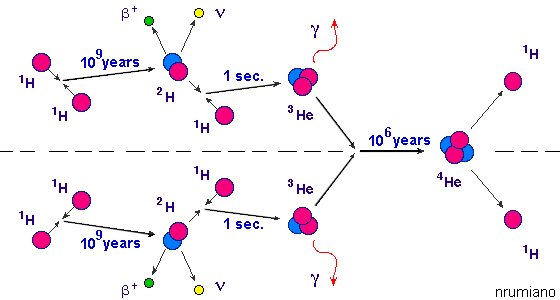O que é a fusão nuclear?
Numa reacção de fusão nuclear dois ou mais núcleos atómicos juntam-se para formar um núcleo atómico mais pesado. Por exemplo, no interior do Sol, temos a fusão nuclear do Hidrogénio em Hélio. Neste processo quatro núcleos de hidrogénio (protões) juntam-se para formar um núcleo de hélio havendo ainda a libertação de fotões gama altamente energéticos e neutrinos. Os neutrinos abandonam rapidamente o Sol pois interagem muito pouco com a matéria. Os fotões por sua vez efectuam uma viagem mais ou menos complexa (sendo absorvidos e reemitidos por diversas vezes) e demorada (cerca de 1 milhão de anos), durante a qual perdem grande parte da sua energia, até a superfície do Sol.

Esquema simplificado da fusão nuclear do higrogénio em hélio no interior de uma estrela / Simplified sketch of the nuclear fusion of Hydrogen into Helium inside a star.
(http://nrumiano.free.fr/Estars/energy.html)
A fusão nuclear do hidrogénio leva à formação de um núcleo de hélio no centro da estrela. Quando este tiver massa suficiente terão lugar as reacções de fusão nuclear do hélio em carbono. No caso do Sol o processo para por aqui no que diz respeito à fusão nuclear. Para as estrelas de maior massa a fusão nuclear continua com a formação de elementos mais pesados até ao Ferro.
De notar que para que ocorra a fusão nuclear há que aproximar o suficiente os núcleos atómicos e, para isso, há que vencer a força electromagnética que é, neste caso, repulsiva (os núcleos atómicos têm carga eléctrica positiva e portanto tendem a repelir-se uns aos outros). No caso das estrelas, como o Sol, essa barreira de potencial é vencida graças à elevada temperatura, pressão e densidade verificadas seu interior.
What is nuclear fusion?
In a nuclear fusion reaction two or more atomic nuclei
join to form a heavier atomic nucleus. For example, inside the Sun, we have
nuclear fusion of Hydrogen into Helium. In this process four nuclei of Hydrogen
(protons) join to form a nucleus of Helium with the release of high energy
photons and neutrinos. The neutrinos rapidly abandon the Sun because they
interact very little with matter. The photons have a much more complex (being
absorbed and reemitted a number of times) and longer (about 1 million years)
journey, during which time they loose most of their energy, until they reach the
surface of the Sun.
The nuclear fusion of Hydrogen leads to the formation
of a nucleus of Helium in the centre of the star. When it has sufficient mass
nuclear reactions of Helium into Carbon will then take place. In the case of our
Sun we have the above nuclear fusion. For stars with higher masses the nuclear
fusion will continue with the formation of heavier elements until Iron.
Note that for nuclear fusion to occur the atomic nuclei
have to be sufficiently close and, for that to be possible, they have to
overcome the electromagnetic force which is, in this case, repulsive (the atomic
nuclei have positive electric charge and tend to repel one another). In the case
of stars, like the Sun, that potential barrier is overcome due to the very high
temperature, pressure and density that occur in its interior.
